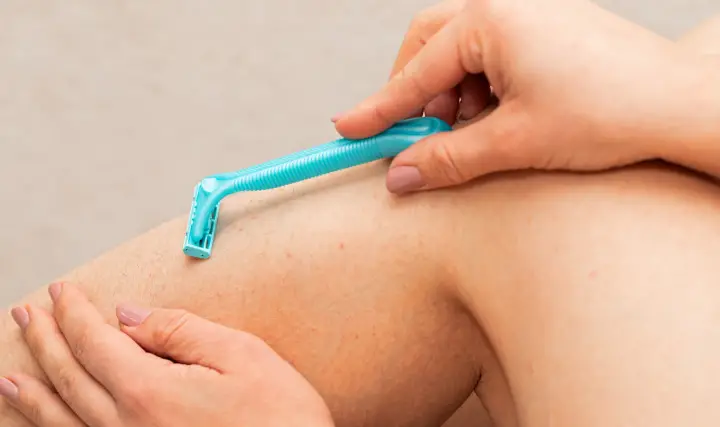We are going to discuss one of the most frequently asked questions. The question is whether the treated area can be shaved days again after a photoepilation session or whether it is necessary to wait until the day before the next one.
The answer applies to both laser hair removal and intense pulsed light (IPL) treatments.
At present, laser hair removal sessions are the only method that guarantees permanent results, removing unwanted hair in a percentage of between 75% and 95%.
Even so, while the treatment lasts, it is possible that we may need to remove some hair from the legs, bikini line or underarms between sessions.
And the most important thing: safely and without negatively affecting the planning carried out by the experts at the beauty center. To answer this question, we have prepared some tips for you on how to remove hair after laser hair removal.
Take note: if you are thinking about saying goodbye to hair once and for all, here’s everything you need to know if you’re in the middle of laser treatment and want to remove your hair before the next session.

How does laser hair removal work?
Although we’re going to deal with how to remove hair after laser hair removal, it doesn’t hurt to remember how this technique works.
As you probably know, it involves the application of a beam of light with a specific wavelength – for example, 800 nm (dark red) in the case of the diode laser or 755 nm (red) in the case of the alexandrite laser – that passes through the skin to reach the root of the hair to destroy it.
Unlike X-rays, the laser does not emit ionizing radiation that is harmful to the body.
Laser hair removal sessions are virtually painless: at most, the patient may feel a slight tingling or tingling during the sessions.
However, to increase comfort, at Grupostop, we offer the exclusive Air Cool System ®, which calms the skin by administering cold air.
Although the data will vary depending on the treated area, each shot or laser pulse covers an area of about 2 cm2, which is equivalent to about ten hairs on average.
As the sessions progress, there is an alteration in the growth of facial and body hair, which is reduced in number and thickness. The frequency of hair removal is also spaced out, from the initial four weeks to several months.
Final Result
Although the laser offers visible results from the first session, it usually takes about four sessions for hair removal to be significant.
This is because not all hairs are at the same stage of hair growth, so they do not all suffer the same impact or damage.
Hence, several sessions are prescribed each time a laser hair removal program is initiated.
The objective of laser hair removal is to destroy the hair in the anagen or growth phase. When hair follicle is wider at the base than at the shaft (under normal conditions, the anagen phase is considered to last about three years).
Another cause that may cause the treatment to be extended is the presence of fine or blond hair, which is more resistant to the laser.
This response to the low levels of melanin it concentrates, since the laser acts by heating the follicle, thanks to the fact that this dark pigment absorbs the light emitted.
In general, about six sessions are usually sufficient to treat the desired area satisfactorily. For optimal results, some patients require a maintenance session every six months or once a year.
It should also be noted that people with hormonal disorders or who have used waxing or tweezing for a long time tend to need a few more sessions.

Hair removal tips before and after laser hair removal
As we have seen, the laser acts on the root of the hair, so avoid pulling the hair out by the root during the second or third week before treatment.
However, if we want to remove it before the next scheduled appointment, keep in mind that the best option is to shave the hair or use a depilatory cream -these cut the hair 1 mm below the skin-and never pull it out with wax or razors (on the other hand, shaving razors can be used).
And what happens once we have started the hair removal sessions? In this case, the motto will be the same: do not use hair removal methods between sessions that affect the root of the hair.
For this reason, experts recommend only shaving. In this regard, the myth that hair grows stronger or thicker after shaving should be discarded once and for all.
What actually happens is that, by cutting it, we have the optical effect that it is thicker since these hairs do not end up in a finer tip like those that have never been trimmed.
Precautions
With regard to depilatory foams and creams, as it is a chemical cutting system, it is preferable not to use them.
This is because some of the ingredients included in their formulation may adversely affect the skin, which will be more sensitive due to the action of the laser.
On the other hand, shaving should be done in one direction only. This will reduce the likelihood of cuts in the skin, which would negatively affect the effectiveness of the laser.
To avoid worsening a possible reddening of the dermis, we advise you to use a moisturizing or moisturizing product. This will reduce friction and possible irritation that razor blades usually cause.
For perfect skin care during these months, take a look at this article on what creams to use after laser.
In any case, most often, the shaved hair will start to fall out from the root within 15 days to three weeks after the laser session.
So if you don’t have anything on your schedule that will make you look flawless on a certain date – say, a wedding – you don’t need to worry about how to shave after laser hair removal.
Once you’ve finished the treatment – and although you may need an occasional refresher session – you can choose the hair removal method that suits you best (but do not use those that pull the hair out by the roots during the month after the last laser session.

DO YOU KNOW HOW TO REMOVE HAIR AFTER LASER HAIR REMOVAL?
If you are interested in laser hair removal, say goodbye to body hair once and for all, you will be interested in knowing how to remove hair after laser hair removal.
There are a series of guidelines to follow between sessions as well as after the treatment is complete.
Laser hair removal has evolved rapidly in recent years. It currently offers extraordinary results, both in quantity and quality of hair removed in the treated areas. Patients are very satisfied with the results.
In addition, the results are visible from the first session, which is a great plus. A great method to forget once and for all about waxing or razor shaving, which causes skin irritation and wounds.
This is why laser hair removal is currently the most popular hair removal technique for both men and women.
Do you know how to epilate after laser hair removal?
- Depilation between laser hair removal sessions
- What is the best hair removal option? (Shaving)
- What to do after the laser hair removal treatment?
HAIR REMOVAL BETWEEN LASER HAIR REMOVAL SESSIONS
One of the main requirements before beginning laser hair removal treatment is not to have it depilated with any technique that pulls out the hair by the root at least 30 days before the first session.
In addition, it is essential to avoid exposure to sunlight for a prolonged period of time, as well as discoloration of the area to be treated.
These are fundamental aspects both to be able to start the sessions and to obtain the best results.
Many women who start this treatment wonder how they have to depilate between sessions if body hair grows.
This is common during the summer months, when hair grows on the legs or groin, for example, between the first sessions, and they want to go to the beach.
WHAT IS THE BEST HAIR REMOVAL OPTION? (SHAVING)
The recommendations for laser hair removal sessions are practically the same as before starting treatment.
You do not have to use hair removal techniques that pull the hair out by the root, such as waxing. As specialists, we recommend shaving because it does not pull the hair out but simply trims it so that it is not visible.
To be successful with shaving and to ensure that the skin is flawless, shaving should be done in one direction. This is done only to minimize the risk of skin cuts, which can affect the effectiveness of the laser.
In addition, the skin should be slightly damp, and you should apply some foam to make shaving easier by reducing skin friction.
In any case, the shaved hair falls out about two weeks after the laser hair removal session. Therefore, you may not even need to shave between sessions, leaving the hair as is.
We only recommend shaving if you are going to the beach or wearing shorts in the summer and you are self-conscious about body hair.
In winter, it is best to leave the hair as it is. This will let the laser take its effect in its own time.
Shaving tips
If you opt for shaving as a hair removal technique between laser hair removal sessions, you will certainly be interested to know a number of basic tips to make hair removal more effective.
The day before, exfoliate your skin to remove dead skin cells and accumulated impurities. Use a specific product for your skin type. This will make it easier to remove the hair that has been trapped under the dirt.
To remove all the residues deposited on the skin, it is highly recommended that you take a shower with warm water just before shaving.
Under no circumstances should you use the razor with water alone. Apply a cream or gel to make the razor glide more easily.
Of course, you should choose a good razor. The best ones are those with a moisturizing gel strip. This is because they make it easier to glide over the skin, thus minimizing the risk of wounds and cuts.
And finally, after epilation, apply a few drops of natural moisturizing vegetable oil to soothe the skin.
WHAT TO DO WHEN THE LASER HAIR REMOVAL TREATMENT IS FINISHED?
Once the laser hair removal treatment is over, one of the first things you should know is that fine and light hairs are the most resistant.
If this is your case, it is possible that some hairs have resisted. This is something you should be aware of right from the start.
After the last session, you can use the hair removal technique you like best. The hair that could be removed has already been removed, and what’s better: it will never grow back.
There is a kind of urban legend that hair grows much stronger after shaving. But this is not true.
Therefore, you can shave the area that has been laser-treated after the treatment is over without fear of the hair growing back.
But, in the vast majority of cases, it is not necessary to use any hair removal technique. Laser treatment is currently very effective and achieves a hair removal rate of about 80%.
The stubborn hair that remains is very fine and small, so it is not worth shaving. In this case, you could opt for waxing.
Conclusion
We’re going to give you a few quick guidelines on how to shave. The objective is to remove any hair that protrudes from the skin at the time of the session.
This should be done carefully, avoiding irritation that could damage the treatment.
Thus, it is best to shave the area when it is wet. You can also do this after having applied a layer of foam or a similar product. If you always shave in the same direction as the hair, you will reduce skin irritation and small cuts.
In any case, make sure the razor blade is clean and sharp.
And we conclude with a clarification contrary to popular belief: shaving does not change the morphology of the hair, its color, or its follicular growth rate.